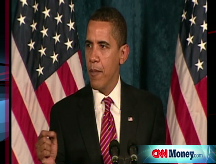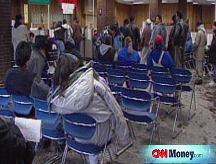Bond market calls the Fed's bluff
Long-term yields rose after the jobs report, a sign that bond investors are daring the Fed to start buying Treasurys and are worried about the cost of stimulus.

 |
| Long-term bond rates are still relatively low. But they've shot higher this year even in the face of weak economic data. |
NEW YORK (CNNMoney.com) -- There's an interesting battle royale going on in the Treasury market.
In one corner, we have the Fighting Fed! The Federal Reserve, determined to keep long-term interest rates down, indicated last week that it was prepared to buy longer-term Treasurys if it thought that would be "particularly effective in improving conditions in private credit markets."
In the other corner, there's the Bond Vigilantes! Traders of U.S. Treasurys are intent on selling bonds because they are spooked by the possibility of a glut of Treasurys if the Obama administration's stimulus plan is approved by Congress.
So far, the bond investors are winning this battle handily. It's not even close.
In the wake of the worse-than-expected jobs report Friday, which will probably increase the urgency to get some sort of stimulus package finalized soon, long-term Treasury prices fell, pushing the yield on the U.S. 10-year up to about 2.98%. (Bond prices and rates moves in opposite directions.)
This is significant because yields were about 2.5% following the Fed's statement about possibly buying Treasurys last week. What's more, if the yield on the 10-year tops 3% anytime soon, it would be the first time above that threshold since late November.
What's this all mean? For one, it shows that bond investors are worried about the cost of stimulus, i.e. that more Treasurys will have to be issued to help pay for it.
And with auctions for 10-year and 30-year Treasurys planned next week, one fixed income expert said it's possible that long-term rates will shoot even higher.
"The government has to pay for stimulus somehow. The market is fearful of the new supply," said Brian Battle, vice president with Performance Trust Capital Partners, a fixed-income trading firm based in Chicago.
Even though the plummeting prices of homes, commodities and stocks are a signal that deflation could become a problem, anytime the government wants to flood the market with more Treasurys, it creates the potential for inflation.
"Something is needed but the government may go too far. Deflation is a risk but the bigger risk is what stimulus will do to longer-term inflation down the road," said Matt King, chief investment officer for Bell Investment Advisors in Oakland, Calif.
Typically, falling long-term bond yields are a signal of a weak economy while rising bond rates are an indication of inflation concerns.
But Scott Colyer, chief executive officer for Advisors Asset Management, an investment firm based in Monument, Colo., said that he doesn't think the decline in Treasury prices is really a cause for concern.
He pointed out that what's going on is more of a normalization in the credit markets as opposed to fears of a looming supply glut of bonds. He thinks yields are returning to more normal values following a massive inflow into Treasurys following the collapse of Lehman Brothers.
"Extreme risk aversion in the markets is easing. It's fairly clear that Treasurys were the recipient of capital fleeing any type of risk whatsoever last year," Colyer said.
Still, the recent sell-off in bond prices is a slap in the face to the Fed. The bond market is testing the Fed, trying to see if it is serious about buying Treasurys to keep rates low.
"Whether the Fed will do something or not, there is an implied threat," Battle said. "But I think another selloff is coming."
Along those lines, another bond expert said that there is some disbelief about what the Fed might do since the Fed merely repeated last week what it said in December: that it might buy Treasurys.
"Some people were expecting the Fed to say they would start buying Treasurys as opposed to just reiterating they would consider doing it," said Leslie Barbi, head of fixed income for RS Investments, a money manager based in San Francisco.
Now to be sure, even with the big spike in yields over the past week, the 10-Year Treasury is still historically low. But the trend is ominous. Long-term rates have risen by nearly a full percentage point since the end of last year.
Since investors tend to scoop up bonds, and push their yields lower, if they think that Treasurys are a safe place to be in a rocky market, it is troublesome that there has been an exodus from longer-term Treasurys lately. The Fed may become the buyer of last resort.
"It looks more and more like the Treasury is printing money if they just issue more and the Fed is the main buyer of them. I'm not sure if there is enough demand for the tremendous supply," Barbi said.
And if rates keep rising, that may counteract what the Fed and the Obama administration are trying to do to help the economy, namely keeping rates low and getting credit to flow again. ![]()



